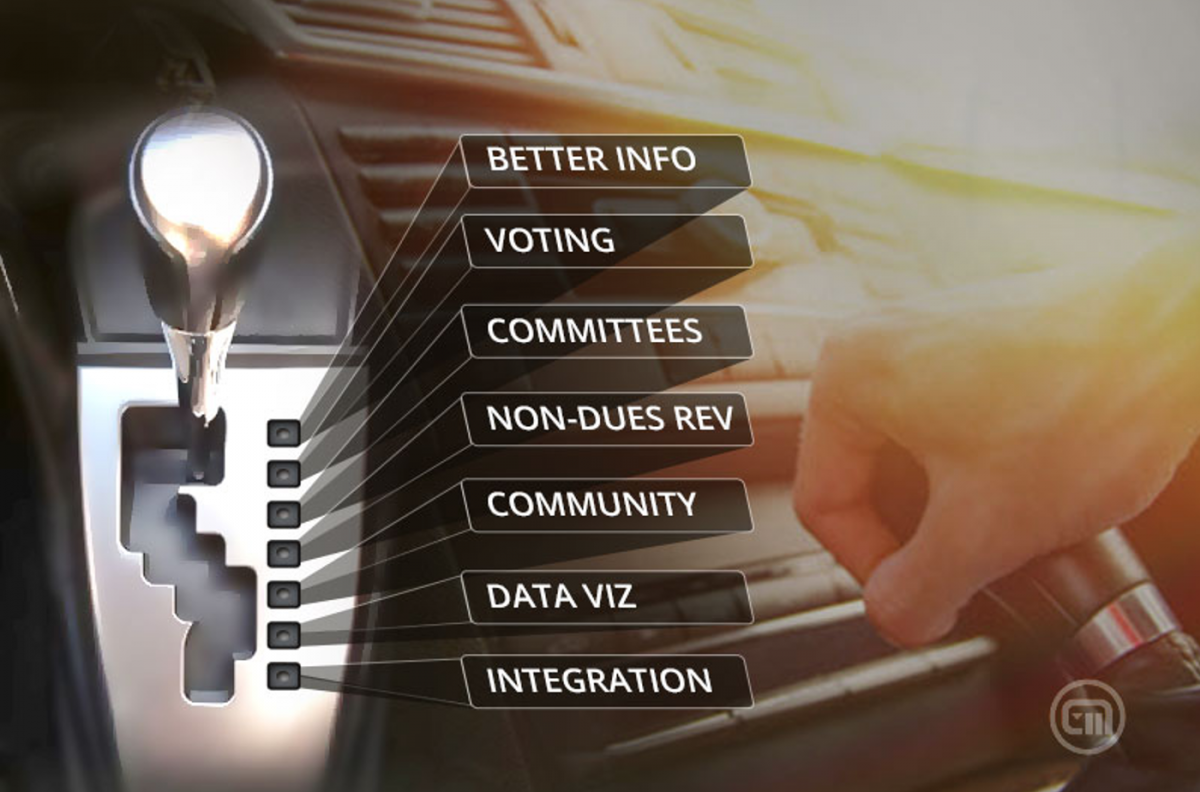
Guest post by Thomas McClintock, Empowered Margins
To keep up with your AMS now, you may need to find a new gear…
Up the Onramp
Associations have known for a couple decades now that one size no longer fits all. In the last 15 years, socially savvy members have stopped depending on the annual meeting for networking. More recently, these members have also become used to consuming media, banking, education, transportation and more through data-intensive, user-friendly, digital platforms.
For example, not long ago the concept of crowdfunding was entirely unknown. Now it has become the leading platform for generating investment for and raising awareness of new ideas. This data revolution has enabled and enticed the digitally fluent to match their personal preferences with the offerings of an organization. That, in turn, has pushed associations in the last decade to learn the art of personalization and embrace disruptive technology.
So the biggest change in associations in recent years are their members, and that change continues, spurring on even more innovation. To keep up with your members, your AMS has had to change, and the good news is that, for the first time, it can draw on game-changing technologies now to do that.
Now associations are learning how to enfranchise more people in an industry vertical, create non-dues revenue from information products, communicate synergistically with the non-members of your industry and bring both an ROI focus and a mission-focus to every investment. And, yes, technology, particularly your AMS and related data-management strategies are playing a critical role.
How? Associations are now giving everyone a voice like never before by using open Application Programming Interfaces (APIs) to enable better information access, grassroots voting, smarter committees, non-dues funding and stronger online community. Associations are also setting in motion better data analytics and visualization to deliver unique industry insights available nowhere else. This data visualization is focused both inwardly and outwardly: scrutinizing the impact of every investment on the association’s bottom line as well as evaluating the impact the association’s mission goals have on the industry as a whole.
Meanwhile tech giants are consolidating the industry by fully integrating software solutions to add seamless email marketing, accounting and post-COVID phygital conferencing, while the Cloud, in its second decade, is helping databases to connect anything to anything more securely at less cost.
Let’s look at just a few examples of how just one now mature technology, open APIs, is bringing about real-time changes at associations like yours.
Putting More of Us in the Driver’s Seat
As concerns for the disenfranchised have become highlighted in recent years, associations are now using technology to give more people a voice in decision making, and open APIs are a big part of that. Open APIs basically enable connections to databases via "methods," which are subroutines in object-oriented programming that only run when called according to predetermined parameters and data.
Methods function like a macro in an Excel worksheet: every time certain data is encountered in a certain place, a predefined process occurs. For example, a "get profile method" automatically connects to the AMS database and fetches member details, eliminating the need to access the database manually and perform a query. Other methods include get invoice, get event, get member, get store order for ecommerce, etc. This makes valuable information more accessible to people who need it.
Another application of open APIs that improves the distribution of influence is facilitating grassroots voting across association memberships. For example, the committees of one maritime association work hard to keep up with the shifting landscape (well, “seascape”) of their industry, from oceanography to safety to insurance to high-tech materials, systems and navigation.
In doing so, they must work together to find the best, most informed ideas from around the globe and then shape them into procedures and specifications to improve the lives of millions involved with industries that rely on marine and freshwater bodies. Working together means that their voting software must use open APIs to connect to their AMS and track documentation, deadlines, milestones and votes of a diverse, international group of policy makers, streamlining their processes and making it easier for committee members to express their opinions while tracking all related data for ongoing analysis.
Reducing Sticker Shock
Open APIs also provide funding for ideas. Earlier, API's were developed to encapsulate business functionality for internal end users to incorporate into web applications, Business Process Management (BPM) solutions, mobile applications, etc. However, today businesses are creating smarter online communities by opening their APIs to external users such as customers, partners and suppliers, thereby creating a seamless network to improve value transfer in all directions, from supply chains to manufacturing to finance and more.
AMSs are now offering this capability to associations so that an external user can integrate an open API into their application and customize it to eliminate the barriers that previously prevented associations from monetizing your unique industry data. This direct integration into your system gives non-member customers, suppliers, researchers, etc. far more freedom to help themselves, like open source software encourages more development innovation, which, in turn, increases the value of industry data only associations possess.
By combining the data procured from open APIs, one standards body, for example, has created a $2 million annual non-dues revenue stream selling to members subscriptions to its continually updated library of information. The underlying software uses some open APIs to fetch the most updated versions of stored documents automatically while other open APIs validate the subscription and track downloads. Other clients use similar connections to track store orders, online transactions, member profiles, etc. across both desktop and mobile applications that are synced on-demand, weekly, nightly or even several or more times per day. All of this makes important data more available anytime, anywhere on earth.
The integration of open APIs in the existing AMS also helps in building stronger online communities by fostering engagement and developing virtual relationships. A case in point is a state municipal organization) which serves as the individual and collective voice of local government officials through meaningful interactions at local, state and national levels.
It fosters these interactions, in part, by leveraging the power of open API integration to unlock member profiles that would otherwise be trapped inside its AMS. Instead, members can search on any of dozens of selected profile elements to identify needed experts based on membership category, location, experience or dozens of other criteria.
It used to be that an association made introductions only by hosting meetings where business cards were exchanged, but in our post-COVID environment, AMS data must be made available on smartphones, and not only sorted by last name. Pulling up the smiling profiles of members you need, but haven’t yet met, right from your phone is the face of empowerment today.
That’s just a little on the changes in APIs. If we expand the scope to encompass, say, the changes in data analysis, we’ll see how going beyond your father’s dashboard can show you right where to look for descriptive, predictive, and prescriptive business intelligence. Add to that fully integrated software solutions such as seamless email marketing, accounting and phygital conferencing, and you unlock a seamless relationship across the multi-channel member experience.
And these are just some of the changes accelerating your AMS down the speedway. A deeper dive into these technologies is no longer just nice to know; it’s fundamental now to being road-worthy. After all, it used to be that your AMS could never quite keep up, but now the roles have reversed: are you keeping up with your AMS?
Buckle up and join us for a free webinar
On Tuesday, March 8, 2022 at 1:00 p.m. EST, join Teri Carden, Founder of ReviewMyAMS and Owens Gollamandala along with Empowered Margins Co-CEO Rudy Pandya and Senior Client Services Manager Tom McClintock for a free webinar to review how clever associations are leveraging newly released AMS functionality, pitfalls they avoided, and how they customized their own data-management strategies, as we traverse the Biggest Shifts About to Happen in AMSs. Register HERE today!
